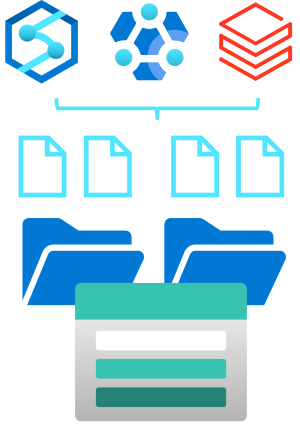Understand Azure Data Lake Storage Gen2
A data lake is a repository of data that is stored in its natural format, usually as blobs or files. Azure Data Lake Storage is a comprehensive, massively scalable, secure, and cost-effective data lake solution for high performance analytics built into Azure.

Azure Data Lake Storage combines a file system with a storage platform to help you quickly identify insights into your data. Data Lake Storage builds on Azure Blob storage capabilities to optimize it specifically for analytics workloads. This integration enables analytics performance, the tiering and data lifecycle management capabilities of Blob storage, and the high-availability, security, and durability capabilities of Azure Storage.
Benefits
Data Lake Storage is designed to deal with this variety and volume of data at exabyte scale while securely handling hundreds of gigabytes of throughput. With this, you can use Data Lake Storage Gen2 as the basis for both real-time and batch solutions.
Hadoop compatible access
A benefit of Data Lake Storage is that you can treat the data as if it's stored in a Hadoop Distributed File System (HDFS). With this feature, you can store the data in one place and access it through compute technologies including Azure Databricks, Azure HDInsight, and Azure Synapse Analytics without moving the data between environments. The data engineer also has the ability to use storage mechanisms such as the parquet format, which is highly compressed and performs well across multiple platforms using an internal columnar storage.
Security
Data Lake Storage supports access control lists (ACLs) and Portable Operating System Interface (POSIX) permissions that don't inherit the permissions of the parent directory. In fact, you can set permissions at a directory level or file level for the data stored within the data lake, providing a much more secure storage system. This security is configurable through technologies such as Hive and Spark or utilities such as Azure Storage Explorer, which runs on Windows, macOS, and Linux. All data that is stored is encrypted at rest by using either Microsoft or customer-managed keys.
Performance
Azure Data Lake Storage organizes the stored data into a hierarchy of directories and subdirectories, much like a file system, for easier navigation. As a result, data processing requires less computational resources, reducing both the time and cost.
Data redundancy
Data Lake Storage takes advantage of the Azure Blob replication models that provide data redundancy in a single data center with locally redundant storage (LRS), or to a secondary region by using the Geo-redundant storage (GRS) option. This feature ensures that your data is always available and protected if catastrophe strikes.
Tip
Whenever planning for a data lake, a data engineer should give thoughtful consideration to structure, data governance, and security. This should include consideration of factors that can influence lake structure and organization, such as:
- Types of data to be stored
- How the data will be transformed
- Who should access the data
- What are the typical access patterns
This approach will help determine how to plan for access control governance across your lake. Data engineers should be proactive in ensuring that the lake doesn't become the proverbial data swamp which becomes inaccessible and non-useful to users due to the lack of data governance and data quality measures. Establishing a baseline and following best practices for Azure Data Lake will help ensure a proper and robust implementation that will allow the organization to grow and gain insight to achieve more.